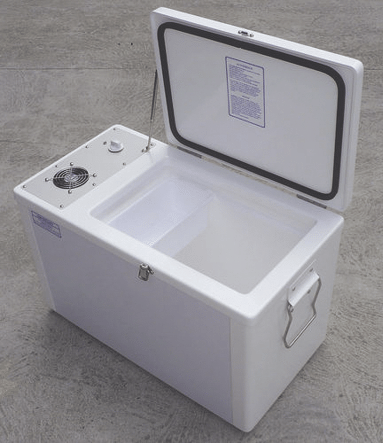by Collyn Rivers
Caravan Fridges
To make caravan fridges work as claimed, and draw less energy, is cheap, simple and easy. Many can be transformed. This article shows how.

Pic: Original source unknown
Fridges do not generate ‘cold’. They pump heat from where it is not wanted to somewhere it does not matter.
Big fridges use more energy than small ones, but not in proportion to their size. Doubling fridge volume will increase energy draw about one and a half times, not twice. Where feasible, use one large fridge – not two smaller ones.
Some cold air is lost when a fridge’s front door is opened. Top-opening fridges lose marginally less. The heat seals of door-opening fridges must be perfect, if they are not, energy usage soars. If they are over three years old, replace them.
Energy consumption
Any fridge’s energy draw relates directly to ambient temperature. All use about 5% more for every 1° C above 25° C. Set temperatures are the same. Fridges need to be +4° C, freezers -18° C (or settle for -14° to save energy).
Cool food before placing it in the fridge. Keep bought frozen goods cold in a heat-insulating bag, and put in the fridge as soon as possible. Defrost anything frozen in the fridge section. Let warm beer first cool overnight. If you keep the fridge full less cold air falls out when opened, so leave gaps for air to move, but fill empty spaces with bottled water.
Most fridges control temperature by cycling on and off. Energy draw relates to the ratio of on times to off times. A fridge that draws more energy but is on less often, or for shorter times, may use less energy per day. Many makers now produce fridges that run constantly: they vary the speed to maintain temperature. For any type of fridge only daily energy draw has any meaning.
Make caravan fridges work as claimed – from solar
It is totally feasible to make electrical caravan fridges work as claimed primarily from solar. A typical 40-110 litre chest and door opening electric fridge draws 0.7-1.0 amp-hours/day per litre of its volume. Larger ones draw slightly less per litre. This requires 150 to 200 watts of solar, and 100 to 150 amp hours battery capacity per 100 litres of fridge volume in temperate areas (up to 30º C). Above 30º C, solar capacity needs increasing by 5% for each 1º C. Alternator charging assists if driving a few hours each day. See dc-dc-charging/
Three-way fridges work well on gas, from the alternator whilst driving and 110/230 volts when available but their energy draw (12-30 amps at 12 volts) is far too high for solar. See below re ‘Climate Class’.
Unrealistic expectations
Fridges must be competently installed. Few are. Improve them by following that shown below. (Owners comparing fridges unknowingly discuss competent or otherwise installation).
No caravan fridge will cool a carton of room temperature beer in an hour or two! Buy beer cold and put it straight in the fridge. Fishers (particularly) grossly underestimate energy needed to freeze their catch. Power draws continuously, doubling or tripling consumption, yet the catch will not freeze quickly. Doing so requires a generator-powered chest freezer.
Correctly installed and sensibly used RV fridges will work as specified, but don’t get carried away by vendor’s claims. Believe the claims in technical data, not those in brochures.
Gas and three-way fridges must suit the climate in which they are used. If not they are not likely to work as you may expect.
Three-way fridges and climate class
Three-way fridges maintain cooling over tightly defined ambient temperatures. These are four (CEN standard) Climate Classes. The ‘SN’, and ‘N’ (Sub Normal, and Normal) units work up to 32° C; ‘ST’, (Sub Tropical) up to 36° C. ‘T’-rated (Tropical) up to 43° C. (T- and ST rated fridges do not work that well below 14°-18° C.) Only ‘Climate Class T’ cool satisfactorily in north and north-west Australia (or tropical areas generally).
Three-way fridges are available in Australia from Chescold, Dometic and Indel. They have an unfair reputation for poor cooling due either to buying one of the wrong Climate Class and/or poor installation. Three-way fridges meet their claims but must be installed as shown above to do so.
Make caravan fridges work as claimed – in tropical areas
When making a fridge work as claimed, it is common (but wrongly) to assume there’s more solar input in tropical areas. There is not. Solar input in the tropics in mid-summer is 20% to 30% less than many expect. High humidity causes haze and some solar energy is lost because of this.
It is also hot all day and often all night, so fridges draw up to 50% more energy, meanwhile, solar modules lose energy through heat loss.
To cope in tropical conditions, your solar system must bring batteries to float voltage in temperate areas by noon on most days
All this is thoroughly covered in my books Solar that Really Works, Solar Success and Caravan & Motorhome Electrics.
Installation
Few RV fridges are correctly installed, including many done ‘professionally’. Making caravan fridges work as claimed is usually possible: sometimes even better than claimed – and often at little or no cost. It is usually easy to do but in extreme cases, it may be necessary to totally re-install.
Here is a far from extreme example: it is of a $550,000 motorhome with a 450-litre fridge totally enclosed and unventilated, plus a 300-litre freezer. Both are in unventilated lockers with black fronts exposed to the sun. Neither cools below about 5 degrees C. Both connect to the battery via cable barely able to run LEDs. The RV maker refuses to accept responsibility – he blames the fridge maker! Fixing required a major rebuild of the kitchen area at a cost of over $10,000!
Heat must escape
Whilst seemingly obvious, a fridge must not be in direct sunlight:
One character, who has his outside in Broome’s full tropical sun, complains: “my b..y mongrel Electrolux won’t keep my %#@^& beer cold.” He’d listen to nobody (including me) explaining why – despite going through a 9 kg (20 lb) LP gas cylinder a week as a result.
The heat from a fridge must be able to exit the caravan – and not re-enter. To do this they need a cool air entry at its base level, and a hot air exit (ideally at roof level). Most need baffles to direct cold air so that it can only flow through or over the cooling fins. Baffles can be made from aluminium, plywood or even cardboard. They must be within a centimetre or two of the cooling fins. Channel rising warm air so none is trapped.
The cool air vent can be at the side or through the floor (but not above or behind an engine’s exhaust outlet). Cool air must enter below the lowest cooling fin and exit well above the highest fin.
The lower inlet is a problem off-road as dust is sucked in. Here, compromise is needed. One way is to have the vent closed off while on dirt roads (but cooling will suffer as a result).
Rising warm air is ideally vented to and through the roof: if not feasible, have a side vent well above the highest cooling fin.
Fridge level is important. Some three-way fridges tolerate 6° tilt, others only 3°, but electric fridges are less sensitive.
The vital requirements

Upper Left: – the baffles are too short. They need to be just below the cooling fins. Rising hot air is trapped in the dead air spaces. If not fixable (bottom centre and right), an extractor fan driven by a 5-watt solar module enhances airflow. Upper right: – the upper air vent is far too low – hot air is trapped in the fins above it, to prevent that, baffles are needed. Below: How to install fridges correctly. Baffles truly help, yet rarely used. Rising hot air is channelled to the outside. Drawing is copyright: rvbooks.com.au
A small extractor fan often assists. Some have an integrated solar panel – this works well as cooling is most needed when sunny. Fans used in large desktop computers are cheap. They run directly from a 5-10 watt solar module or the RV’s 12-volt system. Ideally use fans to extract warm air rather than pumping in cool air – but the difference is minor.

Solar-powered extractor fans (Google for suppliers)
Electrical problems with 12-volt fridges
Most 12 volt fridges have grossly inadequate cabling – many only 25% of that required. Check by seeing if the fridge cools better on 230 volts (where relevant). Cable issues are worsened by faulty fuse holders: and particularly cigarette lighter plugs and associated too small wiring. Scrap such plugs and wire the fridge to the battery by the shortest route.
To check if the cable is too small, with the fridge running, measure the voltage directly across the battery, then directly across the fridge. To ensure it keeps running, do this with the fridge door open. Many caravan fridges have close to 1.0-volt drop. Accept no more than 0.15 – 0.2-volt drop.
Using adequate cable makes an extraordinary difference to make caravan fridges work as claimed. For an electric fridge to battery distance of fewer than four metres, use 4 mm² cable (AWG/B&S 11). Over four metres use 6 mm² cable (AWG/B&S 9). If over four metres, move the battery closer.
Do NOT use the auto cable sold by auto parts and hardware stores without first reading about it below – or in more detail in Caravan & Motorhome Electrics.
Do also see DC-DC Charging – this shows how ensure the caravan battery and fridge receive their full required voltage from the vehicle alternator. This can totally transform a caravan or camper trailer fridge.
Auto cable problems
Appliance makers specify cable by its cross-section in mm². Auto cable makers (in effect) specify it by the size hole you can just push it through. They rate it by its overall diameter including insulation!
Auto cable sold as 4 mm is typically 1.8 mm², but maybe only 1.25 mm². Many caravan electric fridge makers specify 4 mm². But countless fridges are connected by totally inadequate 1.8 mm² auto cable (less than half the minimum specified). No fridges wired that way work remotely as they should and usually can. Direct comparison with other wire gauges is impossible with auto cable as conductor size varies from maker to maker. One exception is that 6 mm auto cable (typically 4.59 mm² – or 10 AWG) can be substituted for 4.0 mm² cable.
Cable current rating trap
Cable ‘ratings’ (e.g. ‘50-amp’ etc) indicate only the current that cable carries before it melts! They tell nothing about voltage drop (as that is also a function of cable length). It’s useless asking most vendors about this because few know it’s even an issue – let alone why. For caravans, locate the battery close as possible to the fridge. If alternator charged, install a dc-dc alternator charger close to that fridge’s battery.
Never use cable lighter than advised above. If you do the fridge cannot work correctly
An exact way of establishing the best cable size is shown in my books, Solar that Really Works, Solar Success and Caravan & Motorhome Electrics.
Problems with three-way fridges
Routine maintenance is required. Check the flame colour: it should be blue. If yellow (or the fridge works well on 12 volts but not on gas), the baffle inside the flue is likely coated with soot. Soot etc also drops down and affects the burner.
Wearing safety glasses and old clothing, use a powerful air compressor to clean that baffle. Do likewise around the burner. Be aware this is a filthy job. You may prefer a fridge repairer to do it – and have them check the LP gas pressure at the same time.
Whilst uncommon, an LP gas fridge may suddenly stop working. This is usually caused by a ‘vapour lock’ due to the caravan being excessively out of level. You can usually fix this by turning the fridge off, and make sure the caravan is level (within 3 degrees) – then turn the fridge back on after a few hours.
A cause of cooling issues with gas fridges in imported RVs (or imported gas fridges) is if they are made for LP gas in a different country. If so, the jets can the wrong size. If so, seek expert advice.
Use three-way fridges as their makers intend. Run them on 12 volts only whilst driving or an hour or so from the battery because they draw too much energy to run from solar.
For caravans, use heavy cabling – ideally 10 to 13.5 mm² – from the alternator to the caravan battery. Consider installing a dc-dc alternator charger close to that caravan battery. Use at least 6 mm² cables from that battery to the fridge.
Make caravan fridges work as claimed – in cars and 4WDs
Making caravan fridges work as claimed in cars and 4WDs is more of a problem. Keep them out of direct sunlight, and leave air space around the grill’s vent areas. It is fine to pack stuff close to or touching them – except for the types shown below (these must have a 50 mm air gap each side as the heat dissipates from their sides).
You can improve all types of fridges (some dramatically) by running a 6 mm² (8 AWG) cable directly from the battery to that fridge (a maximum of four metres away). Use 6 AWG if the distance exceeds four metres.

A few boat and RV fridges, such as this Australian designed and made Autofridge, dissipate heat from their side-walls. These fridges must have an air gap of 50 mm each side. Pic: Autofridge Australia.
Fridge issues generally
Do not over-pack RV fridges as space is needed to allow cool air to circulate.
Door seals leak after a few years. To check, insert a strong strip of this paper (e.g. a banknote) between the door and the seal (at various places around the door) and see if it grips. If not cool air escapes, so replace the seals every three to five years – you can buy replacements from stores such as Clarke Rubber.
Fridges with external cooling fins benefit by adding extra heat insulation. Some fridges, however, such as the Intel and Autofridge (pic above), dissipate heat from their side-walls. If possible have a cool air feed to the base of their sides. They must have an air gap (of 50 mm or so) at either side and their top.
Make caravan fridges work as claimed – summary
It is totally possible to make almost all RV fridges work as claimed (or even better) via the work described above.
Except for the very cheapest fridges, dismiss claims of inherent deficiencies. If a fridge is appropriate for its proposed use, problems are almost always due to faulty installation. For domestic fridges, and fridges in cabins, virtually all of the above is relevant.
Further reading
A great deal more on how to make fridges work as claimed is in my book Caravan & Motorhome Electrics. It even shows how to build your own fridge that leaves commercial units for dead in cooling and economy. That book includes a lot of information about running them from solar. So does Solar that Really Works!
If the fridge is large and in a large home or on a property consider also Solar Success.
There is detailed information about every aspect of caravans and motorhomes in the Caravan & Motorhome Book. For camper trailers see the now second edition Camper Trailer Book.
If you find this article useful you will find my books even more so. Each has updates at typically yearly intervals. RV Books accepts no advertising. It does not accept payment for editorial. It covers the cost of all articles solely from the sale of the associated books.


